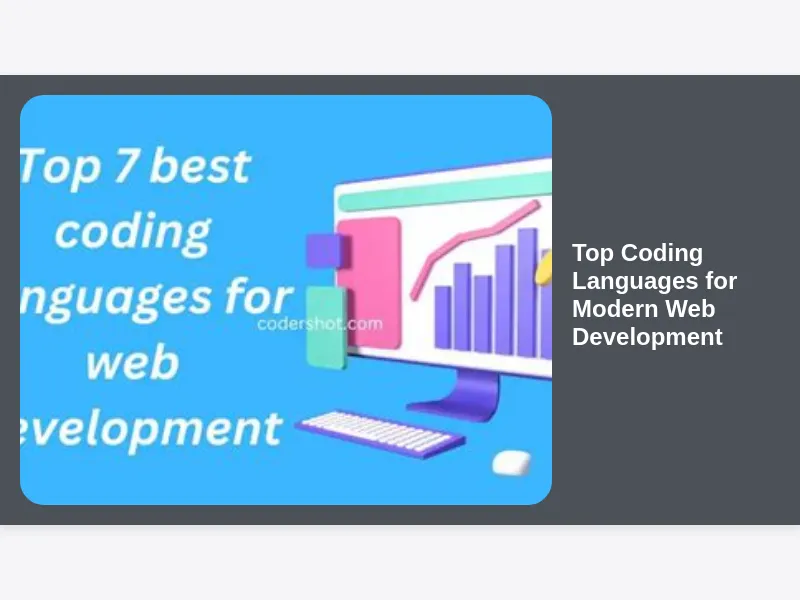Web development is a constantly evolving field, with new technologies and frameworks emerging regularly. Choosing the right coding languages is crucial for building successful and scalable web applications. This article dives into the best coding languages for web development, exploring their strengths, weaknesses, and ideal use cases.
Understanding the Landscape of Web Development Languages
Before diving into specific languages, it's essential to understand the different areas of web development: front-end, back-end, and full-stack. Front-end development focuses on the user interface and user experience (UI/UX), using languages like HTML, CSS, and JavaScript. Back-end development deals with the server-side logic, databases, and APIs, often employing languages such as Python, Java, Node.js, and PHP. Full-stack developers are proficient in both front-end and back-end technologies, allowing them to build complete web applications.
The Reigning Champions: Essential Front-End Languages
HTML (HyperText Markup Language)
HTML is the foundation of every website. It provides the structure and content of web pages, defining elements like headings, paragraphs, images, and links. While HTML is not a programming language, it's essential for creating the basic framework of any website. Think of it as the skeleton upon which everything else is built.
CSS (Cascading Style Sheets)
CSS is used to style the HTML elements, controlling the visual appearance of a website. It allows developers to define colors, fonts, layouts, and responsiveness, ensuring a consistent and visually appealing user experience across different devices. CSS frameworks like Bootstrap and Tailwind CSS can significantly speed up the styling process.
JavaScript: The King of Front-End Interactivity
JavaScript is the powerhouse of front-end development, enabling interactive and dynamic web pages. It allows developers to add animations, handle user input, make API calls, and create single-page applications (SPAs). Frameworks like React, Angular, and Vue.js have revolutionized JavaScript development, providing structure and tools for building complex web applications.
Back-End Powerhouses: Server-Side Scripting and Logic
Python: Versatility and Readability for Web Development
Python is a versatile language widely used in web development, data science, and machine learning. Its clean syntax and extensive libraries make it a popular choice for back-end development. Frameworks like Django and Flask simplify web application development, providing tools for handling routing, database interactions, and security. Python is often chosen for its rapid development capabilities and scalability.
Java: Enterprise-Grade Web Applications
Java is a robust and mature language commonly used in enterprise-level web applications. Its platform independence and scalability make it suitable for building large and complex systems. Frameworks like Spring and Struts provide comprehensive tools for web development, including dependency injection, ORM (Object-Relational Mapping), and security features. Java's strong typing and extensive ecosystem contribute to its reliability and maintainability.
Node.js: JavaScript on the Server
Node.js allows developers to use JavaScript on the server-side, enabling full-stack JavaScript development. It's based on the V8 JavaScript engine and uses an event-driven, non-blocking I/O model, making it highly efficient for handling concurrent requests. Node.js is particularly well-suited for building real-time applications, APIs, and microservices. Frameworks like Express.js simplify the development process, providing a lightweight and flexible foundation for building web applications. Many prefer Node.js due to the reusability of javascript.
PHP: A Veteran of Web Development
PHP is a widely used server-side scripting language that has been powering websites for decades. While it has faced criticism over the years, PHP remains a popular choice for many web developers, particularly for building dynamic websites and content management systems (CMS) like WordPress. Frameworks like Laravel and Symfony have modernized PHP development, providing tools for building robust and maintainable applications.
Full-Stack Frameworks: Simplifying Web Development
MERN Stack: MongoDB, Express.js, React, Node.js
The MERN stack is a popular full-stack JavaScript stack that combines MongoDB (a NoSQL database), Express.js (a Node.js web framework), React (a front-end JavaScript library), and Node.js (a JavaScript runtime environment). It allows developers to build complete web applications using a single language (JavaScript), simplifying the development process and improving code reusability.
MEAN Stack: MongoDB, Express.js, Angular, Node.js
The MEAN stack is another popular full-stack JavaScript stack that uses Angular (a front-end JavaScript framework) instead of React. Like the MERN stack, it provides a complete set of tools for building web applications using JavaScript. Angular's component-based architecture and strong data binding capabilities make it well-suited for building complex and dynamic user interfaces.
Django: A High-Level Python Web Framework
Django is a high-level Python web framework that promotes rapid development and clean, pragmatic design. It provides a wealth of features, including an ORM, a template engine, and a built-in admin interface. Django's





